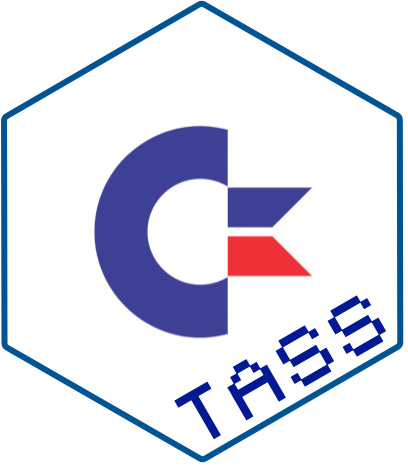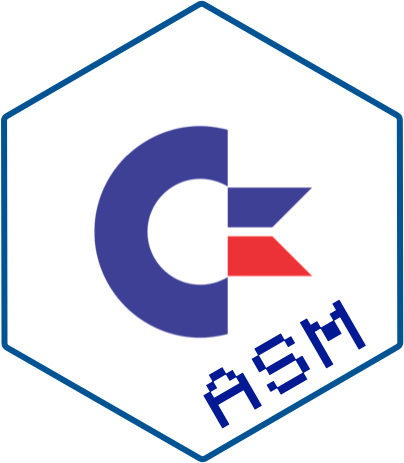{c64asm} is a c64 6502 assembler written in R.
The syntax for the assembly code closely follows that of TASS.
{c64asm} includes syntax extensions which allow for easier integration of pre-computed values and data segments directly from R.
c64 / 6502
The Commodore 64 (c64) is an 8-bit home computer running on a Motorola 6510 (a variant of the 6502).
The c64 supports 16 colours, 8 hardware sprites and a maximum resolution of 320x200 pixels.
It includes co-processors for sound (SID chip) and video (VIC-II) chip.
6502 machine code:
- 3 general purpose registers: A, X, Y
- No multiplication instruction
{c64asm} Features
General features
- Syntax similar to TASS64 syntax.
- Settable program counter
- e.g.
* = $0801
- e.g.
- Defined variables
- e.g.
border = $d020
- e.g.
- Low/High byte extraction from symbol (similar to TASS)
- e.g.
lda #<routinewill store the low byte of the address of symbolroutinein theAregister
- e.g.
For integration with R
-
.rtextdirective to include anRstring as text data -
.rbytedirective to include anRinteger vector as bytes -
{...}to delimit code to be evaluated at run time to manipulate labels and variables e.g.lda {border + 1}
Limitations
- R Errors will be thrown for most syntax errors in the assembly code.
- There are still corner cases which will compile into invalid machine code:
- E.g. if the user orchestrates a
jmpto a location more than 128 bytes away from the current program counter.
- E.g. if the user orchestrates a
-
indirect indexedandindexed indirectmodes using symbolic addresses seems to work, but need more tests. - You may need to force zero page addressing modes with symbols/variables by explicitly noting that only the low byte should be used. e.g.
-
BUFPNT = $A6is the pointer to the tape i/o buffer -
lda <BUFPNTshould be used to force zero page addressing mode, otherwiselda BUFPNTwould assume absolute addressing mode. - The actual result would be the same, but zero page addressing takes fewer bytes and takes fewer CPU cycles to execute than absolute.
-
Installation
devtools::install_github('coolbutuseless/c64asm')Documentation
The documentation for the package is available online at coolbutuseless.github.io (thanks to pkgdown)
Vignettes
-
helloworld- write text to the screen -
helloborder- colour cycling in the border as fast as possible -
helloworld_details- a look at the intermediate assembly outputs during compilation -
ascii- Using R-specific.rbytedirective to put characters from an R variable into the assembly code -
custom_character_set- Building a custom character set in R and passing it into the assemblly code with the.rbytedirective. -
symbol-arithmetic- How to do arithmetic on the program counter and address labels
The code for the vignettes is also available in the prg/ directory of this repository.
A simple 6502 program
The following c64/6502 ASM code will clear the screen and then write Hello #rstats! at the top
asm <- '
*=$0801
.byte $0c, $08, $0a, $00, $9e, $20 ; 10 SYS 2080
.byte $32, $30, $38, $30, $00, $00
.byte $00
*=$0820
lda #$93 ; Clear the screen
jsr $ffd2
ldx #$0 ; initialise the offset pointer into our message
loop lda message,x ; load a character and write it to screen
and #$3f ; Manually place chars on screen
sta $0400,x
inx
cpx #$0e
bne loop
rts
message
.text "Hello #rstats!"
'Compile the program and show the compiled program bytes
prg <- c64asm::compile(asm)
prgBreakdown of assembly process
The compiler makes a few passes through the data to resolve symbol values.
The c64asm::compile() function is just a wrapper which calls the following 4 functions
-
line_tokens <- c64asm::create_line_tokens(asm)- For each line in the input break it into tokens.
- Filter any rows that contain no instructions
-
prg_df <- c64asm::create_prg_df(line_tokens)- Create a data.frame from
line_tokens - This is the key data structure for the compilation process
- The compilation process is just a matter of manipulating this data.frame and merging with information about the instructions
- Create a data.frame from
-
prg_df <- c64asm::process_symbols(prg_df)- Resolve labels to their actual addresses
- Replace any defined variables with their values
-
prg_df <- c64asm::process_zero_padding(prg_df)- If there are gaps between blocks of code, insert sequences of zero bytes 5,
prg <- c6asm::extract_prg_bytes(prg_df) - Extract the vector of raw bytes which represent the c64 PRG executable
- If there are gaps between blocks of code, insert sequences of zero bytes 5,
The actual contents of the c64 prg executable file is the sequence of values in the hexbytes column.






